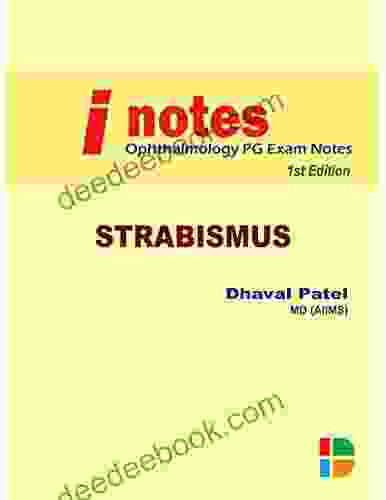Notes Strabismus Ophthalmology Pg Exam Notes: A Comprehensive Guide

Strabismus, commonly known as squint, is a condition in which the eyes are not properly aligned, resulting in abnormal eye movements and potential visual impairment. It is a common condition affecting children and adults, and understanding its various aspects is crucial for ophthalmology PG exam preparation. These comprehensive notes provide a detailed overview of strabismus, encompassing its definition, classification, diagnosis, and management.
Definition of Strabismus
Strabismus is defined as a condition where the visual axes of the eyes are not parallel and do not intersect at the same point of fixation. This misalignment can be constant or intermittent, affecting one or both eyes.
5 out of 5
| Language | : | English |
| File size | : | 317 KB |
| Text-to-Speech | : | Enabled |
| Screen Reader | : | Supported |
| Enhanced typesetting | : | Enabled |
| Print length | : | 92 pages |
| Lending | : | Enabled |
Classification of Strabismus
Strabismus is classified based on various parameters:
- Direction of Deviation:
- Esotropia: Inward deviation of the eye
- Exotropia: Outward deviation of the eye
- Hypertropia: Upward deviation of the eye
- Hypotropia: Downward deviation of the eye
- Onset:
- Congenital: Present at birth or within the first six months of life
- Acquired: Develops after the first six months of life
- Etiology:
- Paralytic: Caused by paresis or paralysis of one or more extraocular muscles
- Non-Paralytic: Not caused by paresis or paralysis of extraocular muscles
Diagnosis of Strabismus
Diagnosis of strabismus involves a comprehensive ophthalmic examination, including:
- History: Including age of onset, symptoms, and any associated medical conditions
- Ocular Motility: Assessment of eye movements, including range of motion and ductions
- Cover-Uncover Test: Alternately covering and uncovering the eyes to observe the eye movements and detect any strabismus
- Prism Test: Using prisms to measure the angle of deviation and determine the type of strabismus
- Fundus Examination: To rule out any underlying ocular abnormalities
Management of Strabismus
Management of strabismus depends on the type and severity of the condition. Treatment options include:
- Observation: Monitoring the condition for stability or progression
- Orthoptic Exercises: Non-surgical exercises to improve eye alignment and coordination
- Glasses: Prescription lenses to correct refractive errors and improve binocular vision
- Prism Therapy: Using prisms in glasses to shift the image on the retina and reduce the angle of deviation
- Surgery: To adjust the length or insertion of extraocular muscles and correct the eye alignment
Specific Types of Strabismus
There are various specific types of strabismus that require individualized management approaches:
- Congenital Esotropia: Inward deviation of the eyes present at birth, often requiring early surgical intervention
- Accommodative Esotropia: Inward deviation of the eyes associated with hyperopia (farsightedness),correctable with glasses
- Intermittent Exotropia: Outward deviation of the eyes that occurs intermittently, particularly at distance fixation
- Paralytic Strabismus: Misalignment of the eyes due to paralysis or paresis of one or more extraocular muscles, requiring specific management depending on the affected muscle(s)
Strabismus is a common condition in ophthalmology that requires proper diagnosis and management. Understanding its definition, classification, diagnosis, and management is crucial for PG exam preparation. These comprehensive notes provide a detailed overview of the topic, covering various aspects of strabismus to enhance your understanding and facilitate your preparation for the exam.
5 out of 5
| Language | : | English |
| File size | : | 317 KB |
| Text-to-Speech | : | Enabled |
| Screen Reader | : | Supported |
| Enhanced typesetting | : | Enabled |
| Print length | : | 92 pages |
| Lending | : | Enabled |
Do you want to contribute by writing guest posts on this blog?
Please contact us and send us a resume of previous articles that you have written.
 Page
Page Chapter
Chapter Story
Story Genre
Genre Library
Library E-book
E-book Magazine
Magazine Sentence
Sentence Shelf
Shelf Glossary
Glossary Bibliography
Bibliography Foreword
Foreword Preface
Preface Footnote
Footnote Codex
Codex Tome
Tome Bestseller
Bestseller Classics
Classics Library card
Library card Memoir
Memoir Dictionary
Dictionary Thesaurus
Thesaurus Narrator
Narrator Character
Character Resolution
Resolution Librarian
Librarian Catalog
Catalog Card Catalog
Card Catalog Borrowing
Borrowing Study
Study Research
Research Academic
Academic Journals
Journals Rare Books
Rare Books Interlibrary
Interlibrary Study Group
Study Group Dissertation
Dissertation Awards
Awards Theory
Theory Textbooks
Textbooks Jessie Newburn
Jessie Newburn Chantel Stephens
Chantel Stephens John Ericson
John Ericson Delene Kvasnicka Of Survivalebooks
Delene Kvasnicka Of Survivalebooks Stephanie Y Evans
Stephanie Y Evans Beth Kery
Beth Kery W Cleon Skousen
W Cleon Skousen Sally Brown
Sally Brown Donna Lynn
Donna Lynn Marty Jacobs
Marty Jacobs Ron Higgins
Ron Higgins Matt Richards
Matt Richards Bell Hooks
Bell Hooks Omair Ahmad
Omair Ahmad Alli Frank
Alli Frank Mary W Craig
Mary W Craig Goal Qpc
Goal Qpc Kenneth Abramowitz
Kenneth Abramowitz Stephen Kantrowitz
Stephen Kantrowitz Lauren Snow
Lauren Snow
Light bulbAdvertise smarter! Our strategic ad space ensures maximum exposure. Reserve your spot today!

 Camden MitchellThe Second Amendment and the Right to Keep and Bear Arms: A Comprehensive...
Camden MitchellThe Second Amendment and the Right to Keep and Bear Arms: A Comprehensive...
 Ken FollettThe Double Lives of Black Women in America: Navigating the Intersections of...
Ken FollettThe Double Lives of Black Women in America: Navigating the Intersections of...
 Darnell MitchellRide Like a Gaucho in the Heart of Patagonia: An Unforgettable Equestrian...
Darnell MitchellRide Like a Gaucho in the Heart of Patagonia: An Unforgettable Equestrian... Richard WrightFollow ·5.3k
Richard WrightFollow ·5.3k Gabriel BlairFollow ·4.4k
Gabriel BlairFollow ·4.4k Charlie ScottFollow ·8.1k
Charlie ScottFollow ·8.1k Ralph TurnerFollow ·18.5k
Ralph TurnerFollow ·18.5k José MartíFollow ·16k
José MartíFollow ·16k Julian PowellFollow ·8.5k
Julian PowellFollow ·8.5k Jan MitchellFollow ·19.1k
Jan MitchellFollow ·19.1k Tennessee WilliamsFollow ·5.6k
Tennessee WilliamsFollow ·5.6k

 Ken Follett
Ken FollettThe Double Lives of Black Women in America: Navigating...
Black women in...

 Cade Simmons
Cade SimmonsBanging My Billionaire Boss: A Love Story for the Ages...
Chapter 1: The Interview I was...

 Brent Foster
Brent FosterThe Struggle for Black Enfranchisement: A Complex and...
The struggle for...

 Henry Green
Henry GreenWhen Savage Needs Love: His BBW Obsession
When Savage Needs Love is a 2019 romantic...

 Alexandre Dumas
Alexandre DumasBlack Women and Public Health: A Historical Examination...
Black women have...
5 out of 5
| Language | : | English |
| File size | : | 317 KB |
| Text-to-Speech | : | Enabled |
| Screen Reader | : | Supported |
| Enhanced typesetting | : | Enabled |
| Print length | : | 92 pages |
| Lending | : | Enabled |








